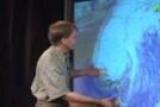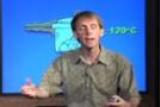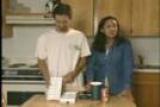Conceptual Chemistry
Chapter 8: How Water Behaves
Evaporation
Evaporation is when a material moves from a liquid to gaseous phase. Evaporation is a cooling process. Duration: 5:27.
Condensation and Evaporation
Condensation and evaporation occur at the same time. Condensation is a warming process, whereas evaporation is a cooling process. Duration: 6:05.
Mobile Link: http://bcove.me/kq6fkd59
Boiling
If water molecules have enough thermal energy, they can escape the liquid phase beneath the surface of the liquid. This is called boiling. Duration: 12:32.
KM: Shrinking Ice Cubes
Maile discovers that water in the form of ice can evaporate. So what is a frost free freezer all about? Duration: 2:16.
Mobile Link: http://bcove.me/ajcrq39o
Watch these additional videos to complete this tutorial.
Table of Videos
- Chapter 1: About Science
- Chapter 2: Particles of Matter
- Chapter 3: Elements of Chemistry
-
Chapter 4: Subatomic Particles
- 4.1 Physical and Conceptual Models
- 4.2 Discovering the Electron
- 4.3 Discovering the Atomic Nucleus
- 4.4 Protons and Neutrons
- 4.5 Light Is a Form of Energy
- 4.6 Atomic Spectra and the Quantum Hypothesis
- 4.7 Electrons Exhibit Wave Properties
- 4.8 Orbitals and Energy-Level Diagrams
- 4.9 The Shell Model and Periodic Table (Plus Chapter Review)
-
Chapter 5: The Atomic Nucleus
- 5.1 Unstable Nuclei
- 5.2 Radioactivity Is Natural
- 5.3 An Imbalance of Forces
- 5.4 Transmutation
- 5.5 Radioactive Half-Life
- 5.6 Isotopic Dating
- 5.7 Nuclear Fission
- 5.8 Mass and Energy
- 5.9 Nuclear Fusion (Plus Chapter Review)
-
Chapter 6: How Atoms Bond
- 6.1 Electron-Dot Structures
- 6.2 Ion Formation
- 6.3 Ionic Bonds
- 6.4 Metallic Bonds
- 6.5 Covalent Bonds
- 6.6 Molecular Shape
- 6.7 Polar Covalent Bonds
- 6.8 Molecular Polarity (Plus Chapter Review)
-
Chapter 7: How Molecules Mix
- 7.1 Dipole Attractions
- 7.2 Solutions
- 7.3 Concentration and the Mole
- 7.4 Solubility
- 7.5 How Soap Works
- 7.6 Softening Hard Water
- 7.7 Purifying Drinking Water (Plus Chapter Review)
-
Chapter 8: How Water Behaves
- 8.1 Open Structured Crystals
- 8.2 Melting and Freezing
- 8.3 The Stickiness of Water
- 8.4 Liquid and Gaseous Phases
- 8.5 Water's Specific Heat
- 8.6 Phase Changes and Energy (Plus Chapter Review)
-
Chapter 9: How Chemicals React
- 9.1 Chemical Equations
- 9.2 Measuring Molecules
- 9.3 Grams and Moles
- 9.4 Exothermic or Endothermic
- 9.5 Entropy and Chemical Reactions
- 9.6 Chemical Kinetics
- 9.7 Chemical Catalysts (Plus Review)
- 9.8 Chemical Equilibrium
-
Chapter 10: Acids and Bases
- 10.1 Exchanging Protons
- 10.2 Acid and Base Strength
- 10.3 Acidic, Basic, or Neutral
- 10.4 Buffers Resist pH Changes
- 10.5 Rainwater Is Acidic
- Ocean Acidification (Plus Chapter Review)
-
Chapter 11: Oxidations and Reductions
- 11.1 Losing and Gaining Electrons
- 11.2 Harnessing the Energy
- 11.3 Electricity from Batteries
- 11.4 Electricity from Fuel Cells
- 11.5 Energy from Photovoltaics
- 11.6 Electrolysis Produces Change
- 11.7 Producing Metals
- 11.8 Corrosion and Combustion (Plus Chapter Review)
-
Chapter 12: Organic Compounds
- 12.1 Hydrocarbons
- 12.2 Unsaturated Hydrocarbons
- 12.3 Functional Groups
- 12.4 Alcohols, Phenols, and Ethers
- 12.5 Amines and Alkaloids
- 12.6 Carbonyl Compounds
- 12.7 Organic Synthesis
- 12.8 Polymer Chemistry
- 12.9 History of Plastics (Plus Chapter Review)
-
Chapter 13: Nutrients of Life
- 13.1 Biomolecules
- 13.2 Carbohydrates
- 13.3 Lipids
- 13.4 Proteins
- 13.5 Nucleic Acids
- 13.6 Vitamins and Minerals
- 13.7 Metabolism
- 13.8 A Healthy Diet (Plus Chapter Review)
-
Chapter 14: Medicinal Chemistry
- 14.1 Medicines Improve Health
- 14.2 The Lock-and-Key Model
- 14.3 Chemotherapy
- 14.4 The Nervous System
- 14.5 Psychoactive Drugs
- 14.6 Pain Relievers
- 14.7 Medicines for the Heart (Plus Chapter Review)
-
Chapter 15: Optimizing Food Production
- 15.1 Humans Eat at All Trophic Levels
- 15.2 Plants Require Nutrients
- 15.3 Soil Fertility
- 15.4 Natural and Synthetic Fertilizers
- 15.5 Pesticides Kill Pests
- 15.6 Past Agricultural Practices
- 15.7 Quality Agricultural Practices (Plus Chapter Review)
-
Chapter 16: Water and Air Resources
- 16.1 Water on the Move
- 16.2 The Water We Consume
- 16.3 How We Pollute Water
- 16.4 Wastewater Treatment
- 16.5 The Earth’s Atmosphere
- 16.6 How We Pollute Air
- 16.7 Global Warming (Plus Chapter Review)
-
Chapter 17: Capturing Energy
- 17.1 Energy through Electricity
- 17.2 Fossil Fuels
- 17.3 The Nuclear Industry
- 17.4 Sustainable Energy Sources
- 17.5 Hydroelectricity
- 17.6 Biomass Is Chemical Energy
- 17.7 Direct Solar Energy
- 17.8 Solar Fuels (Plus Chapter Review)
- Review






